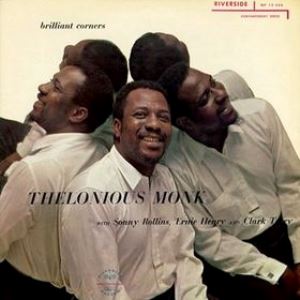Thelonious Monk – Brilliant Corners Riverside RLP 12-226 (1957)
Considered by many to be Monk’s single best album. You’ll get no argument here. This is a great one from the Riverside years, at the height of the hard bop era. I think this has a few particular things going for it that separate it from many other really good Monk albums. One is that it is recorded well. Monk’s earliest recordings featured great performances but the recording technology was rather lo-fi by comparison. This also has good energy. It may not be the frenetic energy of the be-bop era proper, now softened a bit for the hard bop era, but energy is still there in a way that would dissipate quickly in the 1960s. Last, but most importantly, this album is quite varied. It opens with the title track, which was so difficult for the band to play that it actually is presented as an assemblage of excerpts from different takes. It has a great horn riff, played with a kind of teetering machismo that suits the horn players. “Pannonica” is a tribute to Monk’s patron Nica — Baroness Kathleen Annie Pannonica de Koenigswarter (née Rothschild) — featuring him on the celeste rather than piano. It has that unmistakable Monkish quality of playful irreverence, simple and complex at the same time. It sets a completely different mood than “Brilliant Corners.” “Ba-Lue Bolivar Ba-Lues-Are” is also something of a de Koenigswarter tribute, named after the Bolivar Hotel where she lived in New York City. There is one standard, “I Surrender Dear.” The album concludes with the great “Bemsha Swing,” a tangly composition that is one of my favorites. Monk’s compositional style is immediately recognizable in the song. Drummer Max Roach plays tympani, which adds depth to the performance. Across the whole album, Monk is present as a performer but his own playing is hardly a dominant or overriding presence. Despite the many great ides expressed in Monk’s solos, there remains plenty of space for the other performers to express themselves too. This album was greeted with decent sales and a glowing critical reception. Monk regained his cabaret card and launched a famous stand at the Five Spot Café in New York City’s Bowery neighborhood upon its release, which helped raise his recognition within the jazz community at the time and reinforce his continued relevance.

